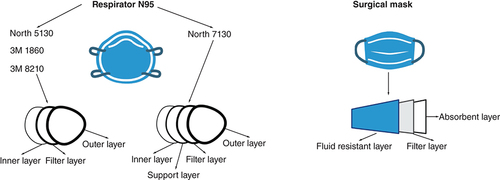Figures & data
Table 1. Characteristics of the masks and respirators used in this study.
Description of the mask and respirator layers used in this study.
Created by Biorender.com.

The virus was deposited on the layers, and after drying, non-adherent viruses were released from the layers by vortexing and according to the method section. (A) Respirator 7130, (B) Respirator 5130, (C) Surgical masks, (D) Respirator 8210 and (E) Respirator 1860. Shown is the mean of at least three independent experiments ± SD. The number located in the lower panel is the cumulative log reduction of the layers. The arrangement of the layers is from the outer layer (A) to the inner layer (C), except for one that has four layers (D).
SD: Standard deviation.

